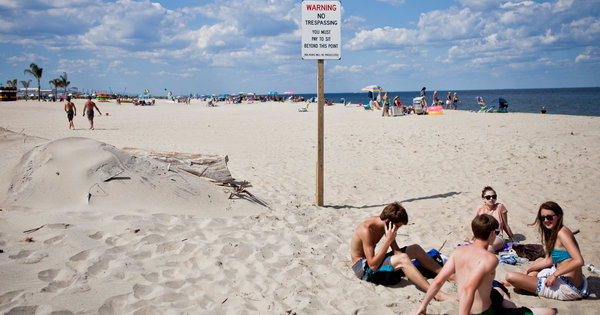
By RICHARD PÉREZ-PEÑA,New York Times, August 12, 2011. SEA BRIGHT, N.J. — If you find the rare parking spot here, and climb one of the few public stairways over the seawall to a crowded patch of sand, you might notice a nearly empty expanse of beach nearby, beyond a “no trespassing” sign.
Step past the sign, and a young man might zoom up on an all-terrain vehicle to shoo you away , warning that this is the property of the Surfrider Beach Club. When questioned one recent afternoon, the young man said he knew nothing of the long-standing legal principle — and, more to the point, a 2009 court settlement — that appear to establish that the portion of beach he was patrolling is open to everyone.
Nearby, a group of friends who drove down for the day from Teaneck obeyed the sign, but it did not sit well. “Look at all that empty beach,” Samantha Soler, 20, said. “It doesn’t seem right.”
This is summer at the Jersey Shore, a low-cost escape for millions of people from several states, most of them unaware that they have stepped into perennial conflicts over how they can use the beaches.
Many places welcome visitors and their business, but for generations, some property owners, neighborhoods and towns have tried to stem that tide with scarce or time-limited parking, claims of private ownership, bans on food and drinks, and paths to the sand that are few in number or disguised.
The wealthy Elberon section of Long Branch has plenty of beach access routes, but some can be hard to discern. One path from Garfield Terrace is fenced off, with a “residents only” sign, though people who know better ignore the sign and go through the gate.
Adams Street, a nearby cul-de-sac, reaches a dead end about 50 yards from the beach, and the remaining distance is landscaped, looking like private property. The shrubs nearly obscure a small blue sign, marking it as public access.
Long Branch agreed to the landscaping recently, to settle a lawsuit filed by Charles Kushner, a real estate developer who was a Democratic power broker before he was convicted in 2005 of witness tampering, tax evasion and making illegal campaign contributions. Mr. Kushner owns the properties on both sides of Adams Street, including a sprawling house, and had sought to take over the strip between them.
Vincent LePore, a local activist who questions the legality of the settlement, called it an example of “rich people getting what they want out of these towns.”
Mr. Kushner did not respond to messages seeking comment.
Fights over outsiders using beaches are as traditional as saltwater taffy and concerts at the Stone Pony, but not at all limited to New Jersey.
On the Rockaways peninsula of Queens, for example, street parking is banned on summer weekends in some neighborhoods, making it nearly impossible for visitors to get to the public beach. In Malibu, Calif., the record impresario David Geffen fought for years to stop people from using a path that cut through his property, before relenting and opening the gate he had installed there.
New Jersey and many other coastal states recognize an ancient principle that a beach should be open to the public from the water’s edge at least up to the “mean high-water line,” a shifting boundary open to varied interpretations. Adding to the uncertainty, the State Supreme Court ruled in 2005 that above that line, the public may also use a stretch of dry sand whose width “will depend on the circumstances.”
Even more contentious is what ability the public should have in gaining access to its sand, since most of the land between the open beach and the nearest street belongs to private homeowners who would just as soon not have their neighborhoods turn into a reality TV show.
The state and the Army Corps of Engineers have said that beaches they have replenished, like ones at Sea Bright, Long Beach and Long Branch, should have public access at least every half mile. But in Sea Bright and some other towns, there are longer stretches where private properties form an uninterrupted barrier, and even where there is access, restrictive parking rules and questionable signage often keeps people away.
Some towns even barred nonresidents from their beaches, until the courts struck that down in the 1980s. And a few years ago, it looked as if things had swung decisively in favor of shore users over shore dwellers.
Enlarge This Image
Gov. Jon S. Corzine’s administration required access points every quarter-mile, and more parking, bathrooms and showers. But the State Supreme Court struck down parts of that policy, and Gov. Chris Christie’s administration said this year that it planned to maintain something like the status quo, giving municipalities ample leeway to set their own rules.
The skirmishes have an element of class resentment; the surfing, angling and other groups that fight for access say that the least welcoming places are in towns like Sea Bright and Deal, where multimillion-dollar homes and private clubs dominate the shoreline. At the other extreme are lower-income towns like Asbury Park and Seaside Heights, which embrace inlanders who fuel their economies.
In a few towns, “the officials or the wealthy residents, or both, want to act like they have private beaches,” said John Weber, Northeast regional manager of the Surfrider Foundation, which has no connection to the beach club.
A few towns, like Long Branch and Long Beach, have split personalities — very accommodating in commercial areas, but not in residential neighborhoods.
Adam Schneider, the mayor of Long Branch for 21 years, said he was committed to public beach rights, but dismissed the idea of treating “an exclusively residential neighborhood that also happens to be an exclusive neighborhood” the same as a town center filled with shops and restaurants.
“We’re never going to satisfy all the fishermen, the surfers, the gadflies,” he said, “and I’m O.K. with that.”
In the residential Loveladies section of Long Beach Township, an outsider finds few places to park and fewer ways to reach the beach. The state’s map of access points shows one gap of more than two-thirds of a mile. Some entrances shown on the map have “private drive” signs, or bushes obscuring the routes.
Town officials say that with no businesses there, and plenty of access and amenities in the center of Long Beach, outsiders have little reason to visit that beach, anyway.
In Sea Bright, private clubs occupy much of the beachfront. Two years ago, those clubs settled a suit filed by the state, acknowledging the public’s right to use 60 percent of the beach, up to a maximum 150 feet inland from the high-tide line.
Beach users say the Surfrider Club, which posted the no-trespassing signs this year, has been the most aggressive about keeping people away. Calls to the club’s owner, James LoBiondo, were not returned.
“Those signs don’t look right to me, I don’t like them and they’ve created a lot of hard feelings, but I don’t know that there’s anything we can do about it,” said Dina Long, who leads the Borough Council’s beach committee.
Ms. Long called the half-mile standard good in principle but unrealistic in practice, as it would require the town to do extensive financial and legal wrangling with property owners. She conceded that public parking is inadequate — the clubs have their own lots — but said there were few alternatives on a peninsula barely a block wide in places.
On the northern shore, all towns charge for use of some or all beaches — as little as $4 for a day pass, and in some places, less than $30 for the season.
Deal, an affluent borough in Monmouth County, charges the state’s highest season pass fee, $125, and while its day pass is just $5, parking restrictions keep day trippers away. Mantoloking, where parking is scarce, charges $12 for a season’s pass, and does not offer a day pass, so it effectively has both the cheapest seasonal rate and the most expensive day rate.
“A place like Deal makes it really clear they don’t want you there,” said Ray Menell, a member of the Asbury Park Fishing Club.
Borough officials did not return calls seeking comment.
Mr. Schneider, the Long Branch mayor, said that without a state standard, some towns would go too far in keeping people out, but that a one-size-fits-all rule was unworkable.
“It’s a tough balance,” he said. “This fight is not going away. It’ll never end.”

